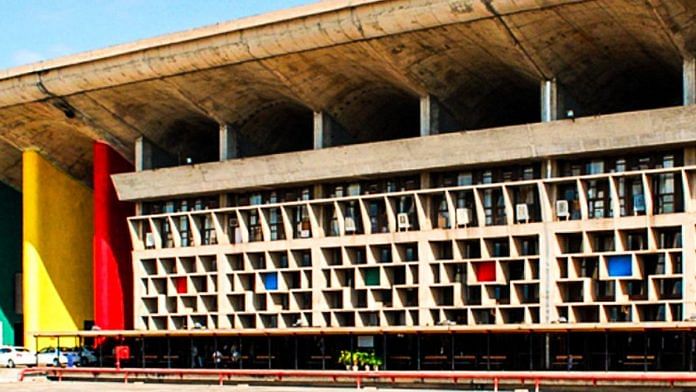Gurugram: The Punjab and Haryana High Court building, part of the Chandigarh Capitol Complex—a UNESCO (United Nations Educational, Scientific and Cultural Organization) World Heritage Site—has found itself at the centre of a legal and administrative tussle.
The Supreme Court on 10 January stayed an order of the Punjab and Haryana HC for the construction of a verandah outside court room number one of the high court, with the government citing concerns over the preservation of the complex’s heritage status.
The high court issued the now-stayed order while hearing a public interest litigation (PIL).
When the PIL was heard again on 10 January, the court was informed of the stay order issued by the SC. Though the high court did not rule on the verandah issue, it instructed the Chandigarh administration Monday to present the terms and conditions that define the high court’s original building as a UNESCO World Heritage Site.
Designed by the legendary French-Swiss architect Le Corbusier in the 1950s, the Capitol Complex, including the high court, was inscribed as a UNESCO World Heritage Site in 2016.
The apex court’s interim order, issued on 10 December, halted the verandah’s construction and stayed contempt notices against C.B. Ojha, chief engineer of the Chandigarh administration.
The controversy stems from the Chandigarh administration’s decision to delay the construction, arguing the need to comply with heritage preservation guidelines.
Court room number one in the Punjab and Haryana HC is the court of the Chief Justice.
Order for construction of the verandah and the notice of contempt to Ojha was issued by a bench comprising Chief Justice Sheel Nagu and Justice Anil Kshetarpal of the high court.
Also Read: Haryana cow protection body’s budget rose to Rs 510 cr from Rs 2 cr in 10 years of BJP rule
Background of dispute
Punjab and Haryana HC had, on 29 November 2024, directed Chandigarh administration to begin construction of the verandah within two weeks and complete it in four. This directive came as part of a PIL filed by Vinod Dhattarwal and others, which addressed infrastructure needs for the high court complex, including parking and access improvements.
Appearing for the Chandigarh administration, its senior standing counsel informed the high court that the proposed map of the verandah covering outside court room number one had been sent to the Archaeological Survey of India (ASI) for approval. The court was also informed that during the 24th meeting of the Chandigarh Heritage Conservation Committee (CHCC) held on 19 September 2024, in-principle approval was granted for the construction of the said verandah in front of court room number one, subject to contacting Fondation Le Corbusier, Paris for sharing the required drawings/data related to the project.
The court observed that it refrained from issuing any direction on 13 November 2024, in light of assurances from the administration that progress was delayed due to pending consultations with CHCC and the requirement to obtain inputs from Fondation Le Corbusier as part of the heritage compliance process. It also said it would revert within 10 days.
Despite assurances by the administration to expedite the project, the high court noted during a 13 December hearing that no tangible progress had been made.
It also observed that verandahs already existed outside court rooms 2 and 9, emphasising that the new construction would not compromise the building’s heritage integrity.
Subsequently, contempt notices were issued to Ojha for non-compliance.
Supreme Court intervention
The Chandigarh administration filed a special leave petition (SLP) in the Supreme Court, challenging the high court’s interim orders.
Senior advocates, including solicitor general Tushar Mehta and amicus curiae P.S. Patwalia, represented the petitioners and respondents during the hearing.
The Supreme Court, while staying the construction, allowed the high court to continue hearing other aspects of the PIL.
Notices were issued to respondents, with a two-week deadline for filing responses.
On the day the Supreme Court passed this order, the PIL was listed before the high court, where the court directed the counsel for the Chandigarh administration to bring on record the legal status of Fondation Le Corbusier, Paris, the terms and conditions under which the high court’s original building was declared a UNESCO World Heritage Site, and the legal status of the CHCC.
Role of UNESCO heritage guidelines
The verandah construction faced delays due to the Capitol Complex’s UNESCO heritage status, which imposes stringent guidelines to preserve its architectural and cultural integrity.
The Chandigarh administration had sought approvals from the ASI and consultations with the CHCC and Fondation Le Corbusier, Paris for the project’s design and compliance.
The Capitol Complex, comprising the high court, secretariat, and legislative assembly, is a globally recognised symbol of modernist architecture. Its inclusion as a UNESCO World Heritage Site ensures rigorous monitoring to prevent alterations that might compromise its authenticity.
In the past, the Chandigarh administration has issued notices to Punjab and Haryana whenever it has observed modifications to the outer structure of the secretariat building.
In 2019, the Chandigarh administration reportedly floated tenders worth Rs 25 crore to restore the original look of the secretariat building, which had changed due to encroachments and the erection of temporary structures.
Other issues in the PIL
The PIL also raised several other issues regarding the High Court complex, including the conversion of forest land near the Rock Garden for non-forest purposes and development of parking facilities near the Jan Marg–Uttar Marg junction.
Other issues raised included the construction of a service road and slip roads for better access and traffic flow, allocation of a sector-17 building for housing the high court’s administrative branches, demarcation of the high court premises in relation to the Sukhna Lake catchment area, functionalising existing parking spaces, and introducing electric rickshaws for commuting within the complex.
(Edited by Radifah Kabir)
Also Read: Haryana ministers seek power to transfer govt employees, CM Saini puts his foot down






